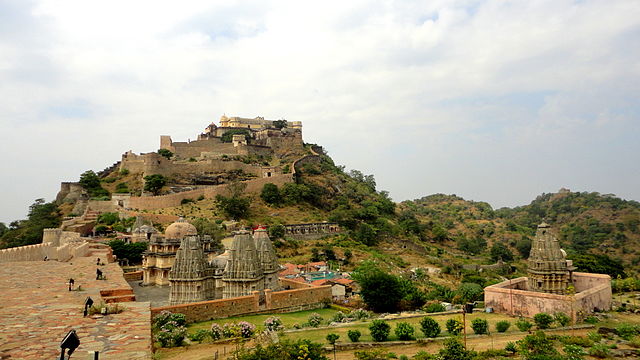Kumbhalgarh Fort
Located between Jodhpur and Udaipur
https://www.youtube.com/watch?v=cyEQWf5AYck
This is a World heritage site
Khumbhalgarh Fort and Kumbhalgarh wildlife sanctuary are the major attractions. Khumbhalgarh fort is easily approachable by road from Ranakpur(18 Km).
Kumbhalgarh Fort is a Mewar fortress on the westerly range of Aravalli Hills, in the Rajsamand District of Rajasthan. Built during the course of the 15th century by Rana Kumbha and enlarged through the 19th century, Kumbhalgarh is also the birthplace of Maharana Pratap, the great king and warrior of Mewar. Occupied until the late 19th century, the fort is now open to the public and is spectacularly lit for a few minutes each evening. Kumbalgarh is situated 82 km northwest of Udaipur by road. It is the most important fort in Mewar after Chittaurgarh.
With a wall over 38 km long, the fort is the second largest wall in the world after the Great Wall of China and the second largest fort in Rajasthan after Chittaurgarh Fort.
Important structures in the fort
Lakhola Tank is the most notable tank inside the Kumbhalgarh fort, constructed by Rana Lakha during 1382-1421 CE. It is located in the Western side of Kelwara town and measures 5 km (3.1 mi) in length to 100 m (0.062 mi) to 200 m (0.12 mi) in width. The tank had a depth of 40 ft (12 m) during independence and since then has been raised to 60 ft (18 m). Aaret Pol is the gate on the western side, Halla Pol with an downward slope from the entrance, Ram Pol and Hanuman Pol near Bavadi are the major gates of the fort. There are inscriptions on the foot of idols in Hanuman Pol detailing the construction of the fort. Bad Shahi Bavdi is a stepped tank, believed to have been built during the invasion of Shahbaz Khan in 1578, the general of Akbar to provide water to the troops.[6] Most buildings are visible from the Ram Pol, which is considered an architectural specimen.
Hindu Temple
A Ganesh temple built on a 12 ft (3.7 m) platform and is considered the earliest of all temples built inside the fort. Neel Kanth Mahadeva temple is located on the eastern side of the fort built during 1458 CE. The central shrine of Shiva is approached through a rectangular enclosure and through a structure supported by 24 huge pillars. The idol of Shiva is made of black stone and is depicted with 12 hands. The inscriptions indicate that the temple was renovated by Rana Shanga.
Jain Temple
Parsva Natha temple (built during 1513), Jain temple on the eastern side and Bawan (52) Jain temples and Golera Jain temple are the major Jain temples in the fort.Mataji temple, also called Kheda Devi temple is located on the southern side of Neela Kanth temple. Mamdeo temple, Pital Shah Jain temple and Surya Mandir (Sun temple) are the other major temples inside the temple.
Culture
The Rajasthan Tourism Department organizes a three-day annual festival in the fort in remembrance of the passion of Maharana Kumbha towards art and architecture. Sound and light shows are organized with the fort as the background. Various concerts and dance events are also organised to commemorate the function. The other events during the festival are Heritage Fort Walk, turban tying, tug-of war and mehendi mandana among others.
Six forts of Rajasthan, namely, Amber Fort, Chittorgarh Fort, Gagron Fort, Jaisalmer Fort, Kumbhalgarh and Ranthambore Fort were included in the UNESCO World Heritage Site list during the 37th meeting of the World Heritage Committee in Phnom Penh during June 2013. They were recognized as a serial cultural property and examples of Rajput military hill architecture.
Source : Wikipedia
https://www.youtube.com/watch?v=VTPnu4AG4Tc
Reviews
Visiting hours : 09.00AM yo 06.00PM, all days of the week
Entry fee : Rs. 10/- for Indians and Rs. 100/- for foreign tourists.



Rate this article